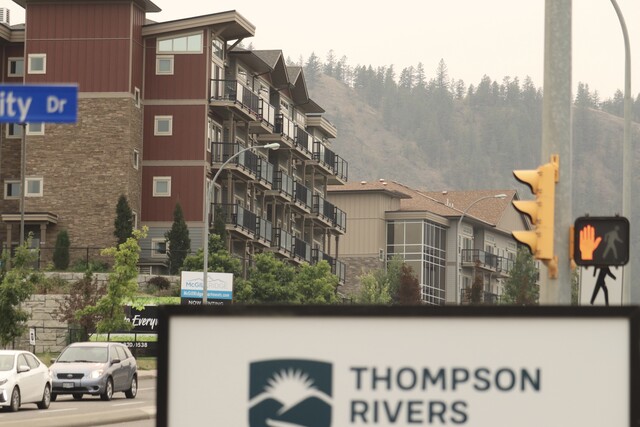Photo: Josh Dawson
Kamloops is starting to see the first indications of what policy changes to international student permits will mean for local residents.
When Immigration, Refugees and Citizenship Canada first announced it would be slashing the number of study permits last year, pressures on housing and health care services were among reasons cited.
More than a year later, Kamloops is starting to see the first indications of what the policy changes could mean for the local community — and cheaper rent might be on the list.
Thompson Rivers University had an estimated 3,150 international students on its campus at the start of the month. That’s a decline from an all-time high over 4,600 several semesters back, and down 26 per cent from 4,282 last fall.
Overall enrolment on the Kamloops campus this fall is expected to be 8,750 students, about 9 per cent less than the 9,638 students in fall 2024.
Alongside the BC Federation of Students, the TRU Students’ Union has been advocating for the ministry to change its funding model for post-secondary institutions for more than a decade, calling it “unsustainable.”
The province announced in 2022 it would conduct a review of post-secondary funding. Despite receiving numerous submissions from institutions, faculty associations and student unions, the review has not been released publicly.
The BC Federation of Students, the Federation of Post-Secondary Educators of BC and the Kamloops and District Chamber of Commerce have all called for the review to be finished and released.
The ministry has said it raised concerns with the federal government about the impact of its “unilateral changes” and is committed to advocating for institutions in B.C. and working with them, but said they are “responsible for administering their own operations.”
TRUSU university affairs coordinator Sierra Rae said B.C. universities have been over-reliant on international student tuition fees to prop up its finances for decades.
She said B.C. institutions, including TRU, were “pretty quick to claim the benefit that international students provide our community,” but now it’s time to face the music.
“The consequences of these decisions for the Kamloops community will be vast, they’ll probably be long lasting,” she told Castanet.
“International Students are a pretty essential part of our community, not just in Kamloops but our broader Interior region, and so their absence from our workforce, from our communities, from our neighbourhoods will certainly be felt.”
This is the final story in a three-part Castanet Kamloops series exploring how declining international enrolment at TRU is expected to impact the community.
Rental demand going down
Kelson Group owns 28 apartment buildings across Kamloops, including two on TRU’s campus and more close by.
President Jason Fawcett said the company is expecting to see softer demand in the local rental market as fewer international students come to the city, and an uptick in vacancies is beginning to push rents down close to campus.
“We’re seeing around one or one-and-a-half to two per cent vacancy in our buildings in Sahali going into September, whereas in past years we would be very close to zero,” he said.
While Fawcett said the vacancy rates aren’t significant, he said it marks the first time in a long time that Kelson Group apartments near TRU have seen vacancies heading into the school year.
Fawcett said the shift has caused rents at some of the company’s apartment buildings near campus to be lowered slightly — by $25 to $50 per month.
“It’s not widespread at this point, but we have decided to lower some rents when we’ve had vacancies a little longer than we’d like to see,” he said, noting Kelson Group buildings further away from the university are seeing less of an impact.
Brendon Ogmundson, chief economist with the BC Real Estate Association, said population projections for adults aged 18 to 34 are a “pretty good proxy” for rental market demand. That population is expected to decline over the next two years before flattening out.
“At least over the next two years where these policies might be in place, I think we could see pretty soft demand,” he said.
“You could, for the first time in quite some time, have vacancy rates rising maybe above 2, 3 per cent. Almost every community in B.C. is under 3 per cent right now.”
According to the Chartered Professional Accountants of B.C., the vacancy rate in Kamloops grew from 1.3 per cent to 1.4 per cent in 2024, while rental rates rose by 3.4 per cent.
Ogmundson said a “suppressed demand” of younger adults across B.C. that are living with parents or multiple roommates could fill the void left by international students, if the vacancy rate keeps climbing.
“That’s kind of up in the air, but we don’t know how many of those suppressed households there are, it is still kind of theoretical,” he said.
Ogmundson said with the decline in international enrolment, as well as the overall reduction of non-permanent residents, rent increases could lower or even decrease as more rental units come online in B.C. during a period of softer demand.
He said lower rental rates could discourage prospective landlords from buying, particularly for smaller rentals like condos, as the return on investment would diminish.
Fawcett said Kelson Group is already beginning to see increased rental demand coming from the recently approved extension of the Highland Valley Copper mine near Logan Lake, and rental demand could further increase if domestic enrolment — which went up five per cent this fall over last year — continues to increase.
“At current levels of what they’re planning, it sounds inevitable that it will be less people that will be coming to Kamloops, and that will mean they will be renting less apartments and other rental homes throughout the city,” Fawcett said.
Regional economy to take hit
According to an economic impact study by TRU released last year, added income into the region from spending by international students in 2023-24 is estimated to be $39.5 million.
The report states an estimated 35 per cent of international students stay in the province after graduating, and those active alumni in the regional workforce are said to add another $53.3 million to the economy.
Laura Lamb, TRU professor and chair of the economics department at the Bob Gaglardi School of Business and Economics, said the decrease in students is bound to cool the region’s economy.
“These type of impacts ripple down throughout the economy — so you think if there’s less people shopping at Superstore, then maybe they don’t need as many workers,” she said.
Lower international enrolment has lead TRU to cut millions from its budget. The university has implemented a partial hiring freeze and offered early retirement packages to its workers.
“That is a marginal change, we’re going to see is that there will be a lower demand for employment positions at TRU because as we reach this new equilibrium with lower students, there’s less revenue coming into pay for different positions,” she said.
“Whether someone takes an early retirement package or their job becomes eliminated, they may or may not stay in the community.”
TRU officials have said the drop in international enrolment is happening faster than expected and the university is planning for layoffs. The TRU Faculty Association has said some sessional faculty are already out of a job.
The economic impact study states payroll and benefits at TRU in 2023-24 to support operations amounted to $175.6 million, and $81.4 million for goods and services. The net impact of these expenditures is an estimated $234.6 million in added income in the region.
While capital projects at TRU that have already been resourced are still moving ahead, like the university’s Low Carbon District Energy System, major capital spending will be scaled way back while revenue is declining.
Lamb said that could impact the region, as well.
“Currently demand for tradespeople has been quite strong, and that’s been an area that’s been identified as in short supply,” she said. “But the deep, permanent decline in international students can have an effect on new projects going forward.”
According to TRU’s economic study, construction spending by TRU created an estimated net impact of $19.6 million in the region in 2023-24.
Will services feel impact?
Lamb said she also expects there to be a decrease in demand on health care services as fewer students arrive on campus.
“We have a doctor shortage, so when students need medical services, they often have to got to emergency just like other people without doctors,” she said.
Interior Health said it didn’t have data readily available regarding how decreased international enrolment could affect demand for medical services, but did say fewer graduates aren’t expected to impact its workforce.
“TRU tells us their health care programs have enough interest from domestic students that a change to international student enrolment would not impact the number of health care workers they graduate,” IH said in a statement.
Former IH CEO Susan Brown said at a board meeting earlier this year that the federal cuts to immigration targets “will have an impact” on the health authority’s regional workforce. IH said it has seen “significant interest” in its efforts to recruit nurses internationally.
An increase in City of Kamloops transit fees started Sept. 1 and further gradual increase are expected until 2029. It’s the first fare increase in the city since 2011, and lower international enrolment at the university was one of the factors cited when the change was recommended by staff.
City transportation engineer Nii Noi Akuetteh said TRU students make up 50 per cent of transit riders in Kamloops, but the main driver behind the fare rase was rising operating costs.
TRU’s campus is one of three major transit exchanges in the city, and Akuetteh said ridership on a bus route that runs between TRU and downtown is expected to slightly decrease alongside enrolment.
“We cannot for sure tell how much drop that would translate into our ridership, because there will still be international students coming in, plus there will still be the domestic students that still use it,” he said.
“But just like every year, depending on how our ridership is, we do make service adjustments or reallocate resources to better serve the growing demand that we see.”
A new route from Valleyview to TRU is and additional hours for a route between campus and the North Shore Exchange is under consideration, and Akuetteh said declining international enrolment isn’t expected to warrant a reduction of bus service to the university.
Akutteh said a material change in parking demand in the city isn’t expected, because many international students either live within walking distance of campus or rely on transit. He said the impact on parking would be localized to campus and the surrounding residential area.
‘Kamloops will be impacted’
Cuts to federal immigration targets, including changes to student visas, are expected to slow K-12 enrolment in B.C., and was one of many factors that were cited for flattening enrolment in the Kamloops-Thompson School District that is among several reasons for recent financial strain.
SD73 superintendent Mike McKay said it wasn’t known definitively whether the federal policy changes will impact school enrolment in the district, but said fewer immigrants with kids and employees at TRU would likely mean fewer students in local classrooms.
“We don’t know what the numbers are, but we could certainly understand the rationale — one plus one equals two or two minus one equals one, kind of impact on us directly,” he said.
Baihua Chadwick, TRU’s vice-president international, said the immigration policies targeted higher education and she doesn’t think school districts will feel much of an impact, but international students in K-12 are now required to acquire a new study permit if they wish to stay. She said that cumbersome process could lower transition rates to post-secondary.
Chadwick said she’s been meeting with local businesses groups, MLAs and MP Frank Caputo, and she also hopes to sit down with Kamloops city council.
“I want them to understand the decreasing enrolment is not just going to impact TRU,” she said.
“It does impact everyone, not just TRU World, but TRU will be seriously impacted — and in turn Kamloops will be impacted.”
Part 1 of this series, published on Monday, examines how some businesses in Kamloops are being affected by the drop in international enrolment. Part 2, published on Tuesday, looks at the potential cultural impacts of a dwindling international student population.


